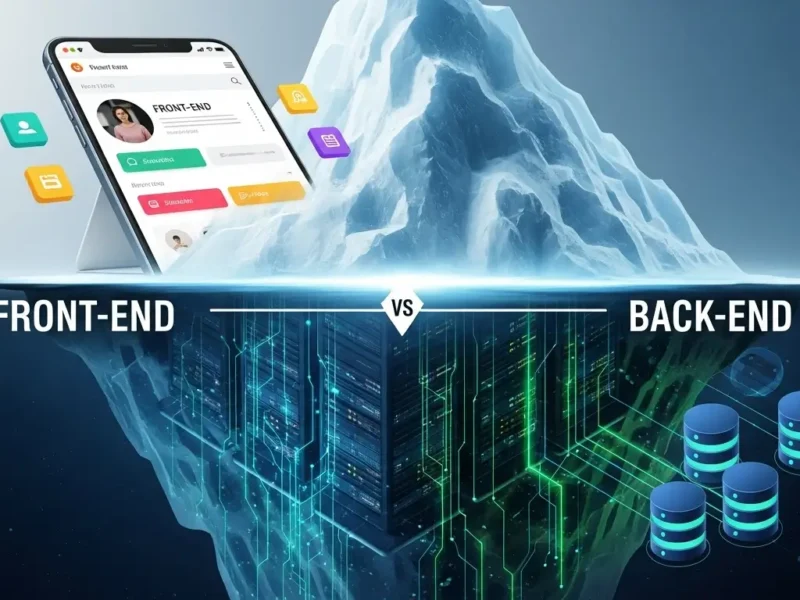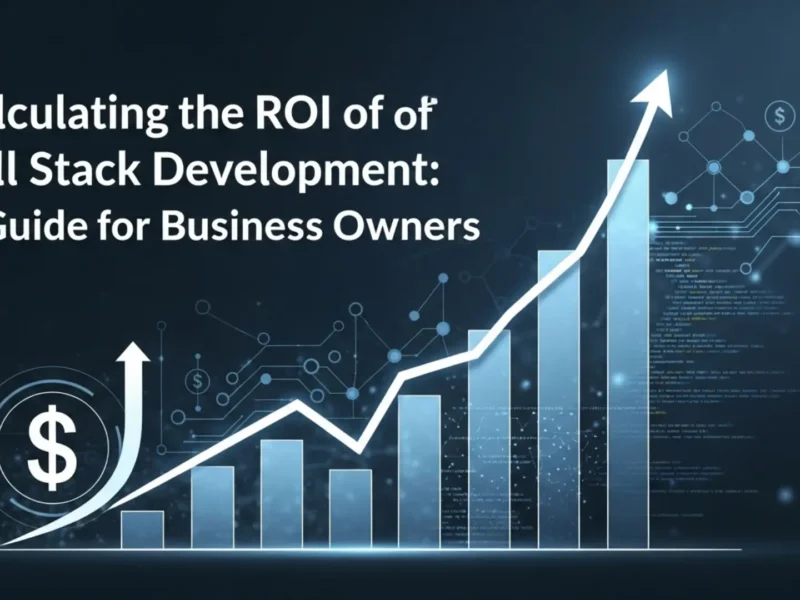The digital landscape is a fiercely competitive arena, demanding robust, intuitive, and scalable applications. For businesses looking to establish a formidable online presence or streamline operations through custom software, partnering with the right full stack development company is not just an advantage – it’s a necessity. This crucial decision, however, is often fraught with challenges. The wrong choice can lead to budget overruns, missed deadlines, and a product that falls short of expectations.
Hiring a full stack development company is a significant investment, akin to bringing on a strategic partner who will translate your vision into a tangible digital asset. To mitigate risks and ensure a successful collaboration, you need to arm yourself with the right questions. This article will guide you through 10 critical inquiries that will help you vet potential full stack development companies, ensuring you select a partner capable of delivering excellence from concept to deployment and beyond.
1. What is Your Core Full Stack Expertise and Preferred Tech Stack?
This is perhaps the most fundamental question when you’re looking to hire a full stack developer team. Full stack encompasses both front-end (user interface and experience) and back-end (server, database, application logic) development. A company’s expertise in specific technologies directly impacts their ability to meet your project’s unique requirements.
- Why it’s critical: You need a company whose technical capabilities align perfectly with your project’s needs. If your vision requires a highly scalable, real-time application, their proficiency in specific frameworks like Node.js, React, or Vue.js, coupled with appropriate database technologies, is paramount.
- What to look for:
- A clear understanding of their strengths across various front-end (e.g., React, Angular, Vue.js, HTML5, CSS3), back-end (e.g., Node.js, Python/Django/Flask, Ruby on Rails, PHP/Laravel, .NET), and database technologies (e.g., MongoDB, PostgreSQL, MySQL).
- An explanation of why they prefer certain tech stacks for specific types of projects and how they choose the right technologies foryourproject.
- Their experience with cloud platforms like AWS, Azure, or Google Cloud, which are crucial for scalable deployments.
- Red flags: Vague answers, claiming expertise in “everything,” or pushing a specific tech stack without understanding your project’s nuances.
2. Can You Share Examples of Similar Projects in Your Portfolio?
Past performance is often the best indicator of future success. When evaluating a custom software development company, their portfolio should speak volumes about their capabilities and the quality of their work.
- Why it’s critical: Relevant examples demonstrate their practical experience with projects similar in scope, industry, or technical complexity to yours. It allows you to assess the quality of their UI/UX design, code robustness, and overall problem-solving abilities.
- What to look for:
- Case studies that detail the challenge, their solution, and the measurable results achieved for previous clients.
- Live demos or links to deployed applications that you can interact with.
- Projects that showcase both their front-end aesthetic and back-end functionality.
- An explanation of their role in each project and the specific challenges they overcame.
- Red flags: A generic portfolio, lack of detailed case studies, or unwillingness to share actual working examples.
3. What Does Your Development Process Look Like (e.g., Agile, Waterfall)?
The development process defines how the project will be managed, executed, and delivered. A well-defined process ensures transparency, efficiency, and client involvement.
- Why it’s critical: Understanding their methodology helps set expectations regarding communication, milestones, and your involvement. Most modern web development companies leverage Agile methodologies (Scrum, Kanban) for their flexibility and iterative nature, which is ideal for evolving project requirements.
- What to look for:
- A clear outline of their phases: discovery, planning, design, development, testing, deployment, and post-launch support.
- Details on their specific Agile practices (sprints, stand-ups, backlog grooming, retrospectives).
- How they involve clients throughout the process, providing regular updates and opportunities for feedback.
- Tools they use for project management (Jira, Trello, Asana).
- Red flags: No defined process, a rigid Waterfall approach for a project with potentially evolving requirements, or lack of client involvement checkpoints.
4. How Do You Ensure Effective Communication and Project Management?
Communication is the backbone of any successful partnership, especially in software development outsourcing. Misunderstandings can derail a project faster than technical challenges.
- Why it’s critical: You need to be confident that your software development partner will maintain clear, consistent communication, keeping you informed about progress, challenges, and decisions.
- What to look for:
- Designated project manager as your primary point of contact.
- Scheduled regular meetings (daily stand-ups, weekly reviews).
- Preferred communication channels (Slack, email, video conferencing).
- Reporting mechanisms: how frequently and in what format will you receive progress reports?
- Their approach to documenting project decisions and technical specifications.
- Red flags: Vague answers about communication, no dedicated project manager, or an expectation that communication will be ad-hoc.
5. What Is Your Approach to Quality Assurance (QA) and Testing?
A beautiful interface and robust back-end are worthless if the application is riddled with bugs. A strong QA process is essential for delivering a reliable and high-performing product.
- Why it’s critical: You want to ensure the final product is stable, secure, and functions as intended across various devices and scenarios. A thorough QA process minimizes post-launch issues and enhances user satisfaction.
- What to look for:
- Details on their testing methodologies: unit testing, integration testing, system testing, user acceptance testing (UAT), performance testing, security testing.
- Whether they have a dedicated QA team or if developers handle testing (a dedicated team is usually preferable for objectivity).
- Use of automated testing tools and frameworks.
- How they handle bug tracking, reporting, and resolution.
- Red flags: Downplaying the importance of QA, no dedicated QA resources, or an overly simplistic approach to testing.
6. How Do You Handle Scope Changes and Feature Requests?
Even with meticulous planning, project requirements can evolve. A clear process for managing changes is vital to avoid conflict and keep the project on track.
- Why it’s critical: Unexpected market shifts or new business insights might necessitate changes to the original scope. A professional full stack development company will have a transparent and fair process for handling these adjustments.
- What to look for:
- A defined “change request” process: how are new features or scope adjustments formally submitted, reviewed, estimated, and approved?
- Their approach to re-estimating timelines and costs associated with changes.
- Flexibility and willingness to adapt, while also managing expectations about the impact of changes.
- Red flags: Unwillingness to discuss scope changes, or an overly rigid stance that could stifle necessary evolution of your product.
7. What Are Your Pricing Models and What’s Included in Your Quote?
Understanding the financial aspect is crucial for budgeting and avoiding hidden costs. Different projects lend themselves to different pricing structures.
- Why it’s critical: Transparent pricing ensures you know exactly what you’re paying for and helps manage your budget effectively.
- What to look for:
- Fixed-price model: Suitable for projects with clearly defined, unchanging scopes. Get a detailed breakdown of all deliverables and milestones.
- Time & Material (T&M) model: Ideal for projects with evolving requirements or where the scope is not fully defined upfront. Understand their hourly rates for different roles (developers, designers, QA, PM).
- What exactly is included in the quote (design, development, QA, project management, deployment, third-party licenses, etc.).
- Their billing cycle and payment terms.
- Red flags: Vague pricing, significant upfront costs without clear milestones, or a reluctance to provide a detailed breakdown of expenses.
8. What Happens After Deployment? Do You Offer Maintenance and Support?
The launch of your application is not the end of the journey; it’s just the beginning. Post-launch support and maintenance are crucial for long-term success.
- Why it’s critical: Software requires ongoing attention – bug fixes, security updates, performance optimizations, and potentially new feature additions. A reliable software development partner will offer comprehensive post-launch services.
- What to look for:
- Availability of post-launch maintenance packages (e.g., hourly, retainer-based).
- Details on their Service Level Agreement (SLA) for bug fixes and critical support.
- Options for ongoing feature development or scalability enhancements.
- How they handle security patches and infrastructure updates.
- Red flags: A company whose responsibility ends at launch, with no clear provisions for ongoing support.
9. How Do You Protect My Intellectual Property (IP) and Data Security?
Your idea, your code, and your user data are invaluable assets. Protecting them is paramount.
- Why it’s critical: You need assurance that your confidential information, project details, and the final code will be legally protected and securely handled.
- What to look for:
- Willingness to sign a Non-Disclosure Agreement (NDA) before detailed discussions begin.
- Clear clauses in their contract stating that all intellectual property developed during the project will be transferred to you upon full payment.
- Their internal security protocols for code repositories, data handling, and employee access.
- Compliance with relevant data privacy regulations (GDPR, CCPA, etc.) if applicable.
- Red flags: Reluctance to sign NDAs, vague answers about IP ownership, or a lack of clear security measures.
10. Can You Provide Client References I Can Contact?
While case studies and portfolios are valuable, speaking directly with past clients provides unfiltered insights into the company’s work ethic, reliability, and responsiveness.
- Why it’s critical: Client references offer an unbiased, third-party perspective on the company’s ability to deliver, manage projects, and handle challenges.
- What to look for:
- Willingness to provide contact information for at least two or three recent clients.
- Contact the references and ask specific questions about their experience:
- Did the project stay on budget and on time?
- How was communication?
- How did they handle challenges or scope changes?
- Would they work with the company again?
- Red flags: Refusal to provide references, or only offering generic testimonials without contact information.
Make Your Decision With Confidence
Choosing the right full stack development company is one of the most impactful decisions you’ll make for your digital product. By diligently asking these 10 critical questions, you’ll gain a comprehensive understanding of a potential partner’s capabilities, processes, and reliability. This due diligence will empower you to make an informed decision, securing a partnership that not only delivers your vision but also contributes to your long-term success.
Ready to bring your innovative idea to life with a trusted development partner?
Don’t leave your project’s success to chance.Contact us today for a complimentary consultation!Our expert full stack development team is ready to answer all your questions and demonstrate how we can transform your vision into a high-performing, scalable digital solution. Let’s build something exceptional together.



